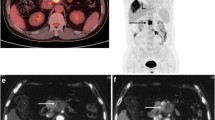Abstract
Metastatic mucinous adenocarcinoma in an inguinal hernia is a rare disease and the image findings of 18F-fluorodeoxyglucose (18F-FDG) positron emission tomography (PET)/computed tomography (CT) are little known. Here, we introduce a 57-year-old man with metastatic mucinous adenocarcinoma in an inguinal hernia. On initial 18F-FDG PET/CT, hypermetabolism was observed in mucinous adenocarcinoma of the cecum, and adenocarcinomas of the transverse and ascending colon, respectively. Follow-up 18F-FDG PET/CT revealed newly developed multiple hypermetabolism in peritoneal seeding masses and nodules in the pelvic cavity and scrotum. Peritoneal carcinomatosis in the right pelvic side wall was extended to the incarcerated peritoneum and mesentery in the right inguinoscrotal hernia.18F-FDG PET/CT was useful to reveal unexpected peritoneal seeding within the inguinal hernia. Also, this case demonstrated that metastatic mucinous adenocarcinomas had variably intense FDG uptake.




Similar content being viewed by others
References
Kingsnorth A, LeBlanc K. Hernias: inguinal and incisional. Lancet. 2003;362:1561–71.
Page B, Paterson C, Young D, O’Dwyer PJ. Pain from primary inguinal hernia and the effect of repair on pain. Br J Surg. 2002;89:1315–8.
Fitzgibbons RJ, Giobbie-Hurder A, Gibbs JO, et al. Watchful waiting vs repair of inguinal hernia in minimally symptomatic men: a randomized clinical trial. JAMA. 2006;295:285–92.
Wasserberg N, Purim O, Bard V, Kundel Y, Gordon N, Groshar D, et al. Early postoperative F-18-FDG PET/CT in high-risk stage III colorectal cancer. Clin Nucl Med. 2015;40:E222–7.
Tural D, Selcukbiricik F, Sager S, Akar E, Yildiz O, Serdengecti S. PET-CT changes the management and improves outcome in patients with recurrent colorectal cancer. J Cancer Res Ther. 2014;10:121–6.
Byun BH, Moon SM, Shin US, Lim I, Kim BI, Choi CW, et al. Prognostic value of (18) F-FDG uptake by regional lymph nodes on pretreatment PET/CT in patients with resectable colorectal cancer. Eur J Nucl Med Mol Imaging. 2014;41:2203–11.
Ogawa S, Itabashi M, Kondo C, Momose M, Sakai S, Kameoka S. Prognostic value of total lesion glycolysis measured by F-18-FDG-PET/CT in patients with colorectal cancer. Anticancer Res. 2015;35:3495–500.
Chang JM, Lee HJ, Lee HY, Lee JJ, Chung JK, Im JG. False positive and false negative FDG-PET scans in various thoracic diseases. Korean J Radiol. 2006;7:57–69.
Berger KL, Nicholson SA, Dehdashti F, Siegel BA. FDG PET evaluation of mucinous neoplasms: correlation of FDG uptake with histopathologic features. AJR Am J Roentgenol. 2000;174:1005–8.
Huang S, Sun C, Li X, Guan J, Feng S, Peng Z, et al. Comprehensive application of CT and PET/CT in diagnosing colorectal mucinous and non-mucinous adenocarcinoma. Zhonghua Wei Chang Wai Ke Za Zhi. 2014;17:230–4.
Murakami S, Saito H, Karino F, Kondo T, Oshita F, Ito H, et al. 18F-fluorodeoxyglucose uptake on positron emission tomography in mucinous adenocarcinoma. Eur J Radiol. 2013;82:e721–5.
Lee JW, Lee SM, Lee MS, Shin HC. Role of (1)(8)F-FDG PET/CT in the prediction of gastric cancer recurrence after curative surgical resection. Eur J Nucl Med Mol Imaging. 2012;39:1425–34.
Nicholson CP, Donohue JH, Thompson GB, Lewis JE. A study of metastatic cancer found during inguinal hernia repair. Cancer. 1992;69:3008–11.
Matsumoto G, Ise H, Inoue H, Ogawa H, Suzuki N, Matsuno S. Metastatic colon carcinoma found within an inguinal hernia sac: report of a case. Surg Today. 2000;30:74–7.
Chung SD, Yu HJ, Lin WC, Huang KH. Metastatic prostatic adenocarcinoma in an inguinal hernia sac in a patient with undetectable serum prostate specific antigen level. J Formos Med Assoc. 2007;106:397–9.
Liu P-H, Kung W-C, Wu Y-C, Chien S-T, Chang W-Y, Hsu C-W. Metastatic malignant gastrointestinal stromal tumor mimicking a right incarcerated inguinal hernia. Formos J Surg. 2014;47:189–92.
Marsden M, Curtis N, McGee S, Bracey E, Branag G, Sleighta S. Intrasaccular caecal adenocarcinoma presenting as enlarging right inguinoscrotal hernia. Int J Surg Case Rep. 2014;5.
Langner C, Harbaum L, Pollheimer MJ, Kornprat P, Lindtner RA, Schlemmer A, et al. Mucinous differentiation in colorectal cancer—indicator of poor prognosis? Histopathology. 2012;60:1060–72.
Bosman FT, World Health Organization, International Agency for Research on Cancer. WHO classification of tumours of the digestive system. 4th ed. World Health Organization classification of tumours, vol 3. International Agency for Research on Cancer: Lyon; 2010.
Foda AAM, El-Hawary AK, Aziz AA. Colorectal adenocarcinoma with mucinous component: relation of MMP-13, EGFR, and E-cadherin expressions to clinicopathological features and prognosis. APMIS. 2015;123:502–8.
Nitsche U, Zimmermann A, Spath C, Muller T, Maak M, Schuster T, et al. Mucinous and signet-ring cell colorectal cancers differ from classical adenocarcinomas in tumor biology and prognosis. Ann Surg. 2013;258:775–82. discussion 82–3.
Author information
Authors and Affiliations
Corresponding authors
Ethics declarations
Conflict of Interest
Hyo Jung Seo, Jae Seon Eo, Byung Wook Min, Sun Il Lee, Sang Hee Kang, Sung Yup Jung, Sang Chul Oh and Jae Gol Choe declare that they have no conflict of interest.
Ethical Statement
All procedures performed in this study involving human participant were in accordance with the ethical standards of the institutional and/or national research committee and with the 1964 Helsinki declaration and its later amendments or comparable ethical standards.
The patient gave his informed consent prior to his inclusion in the study.
Rights and permissions
About this article
Cite this article
Seo, H.J., Min, B.W., Eo, J.S. et al. Usefulness of 18F-FDG PET/CT to Detect Metastatic Mucinous Adenocarcinoma Within an Inguinal Hernia. Nucl Med Mol Imaging 50, 85–89 (2016). https://doi.org/10.1007/s13139-015-0379-4
Received:
Revised:
Accepted:
Published:
Issue Date:
DOI: https://doi.org/10.1007/s13139-015-0379-4




